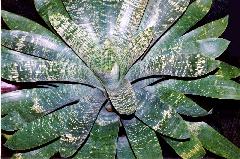
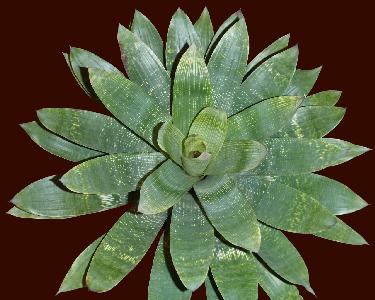
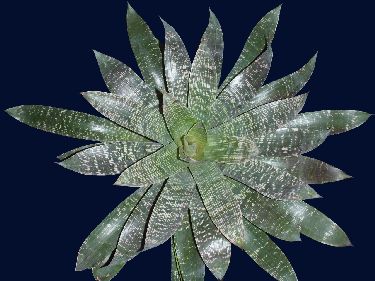
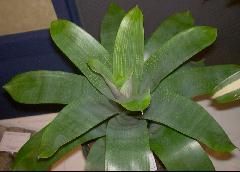
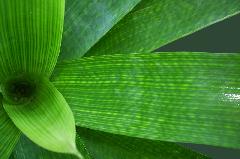
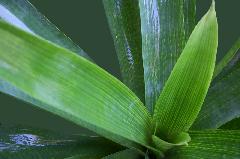
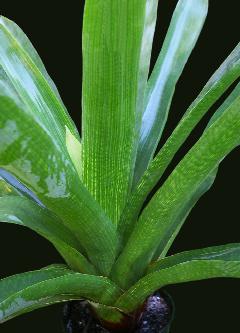
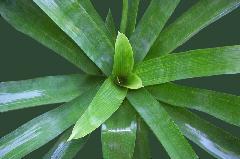
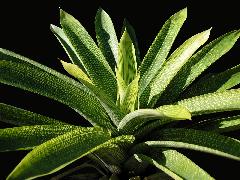
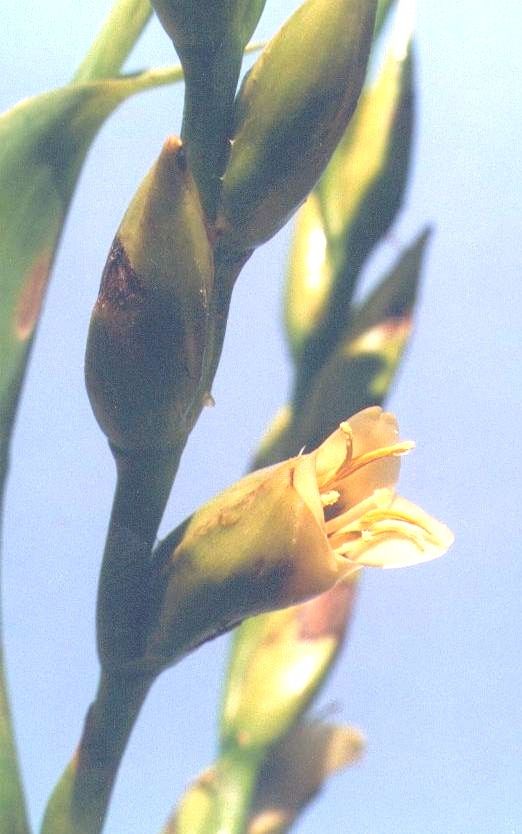
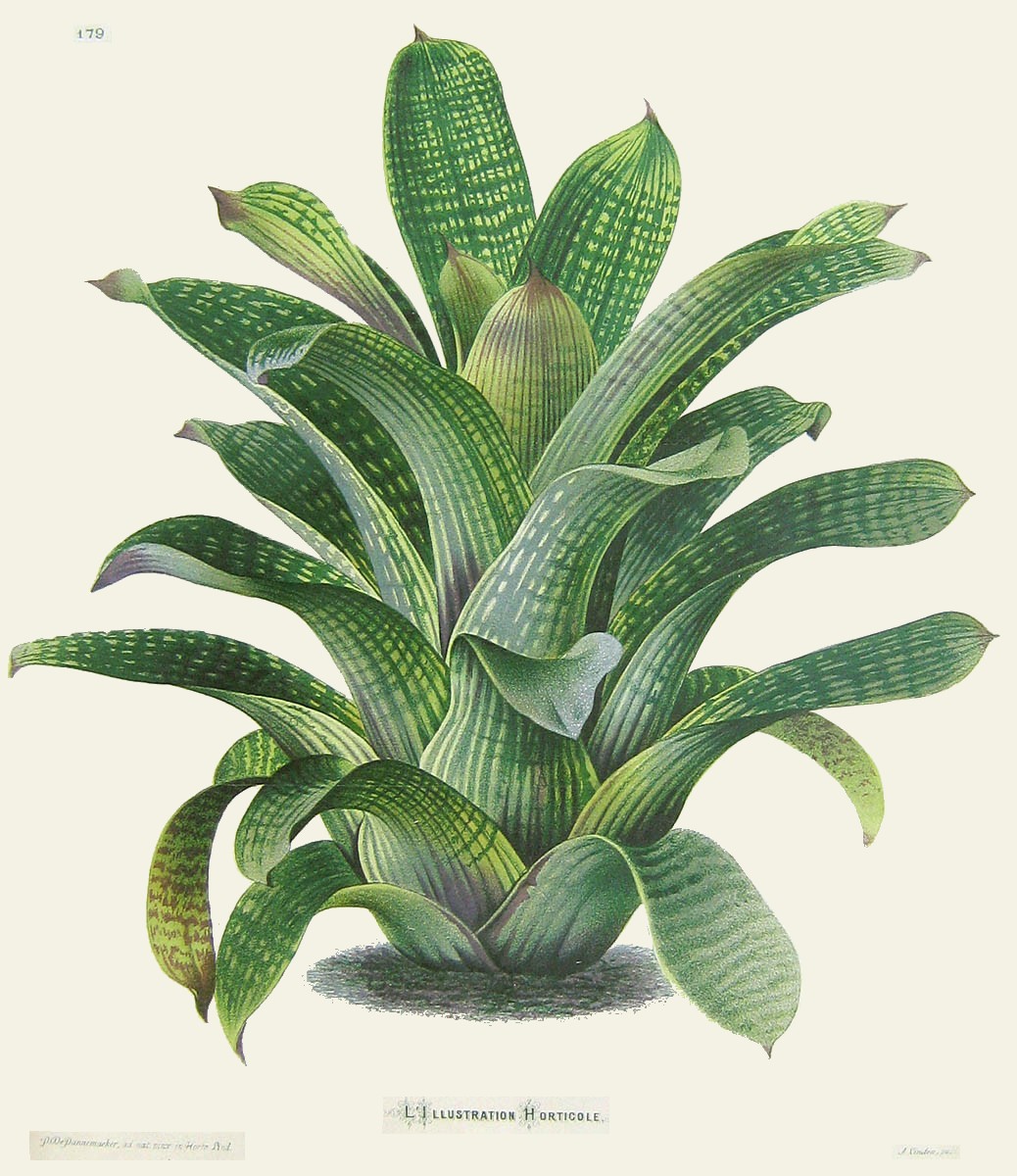
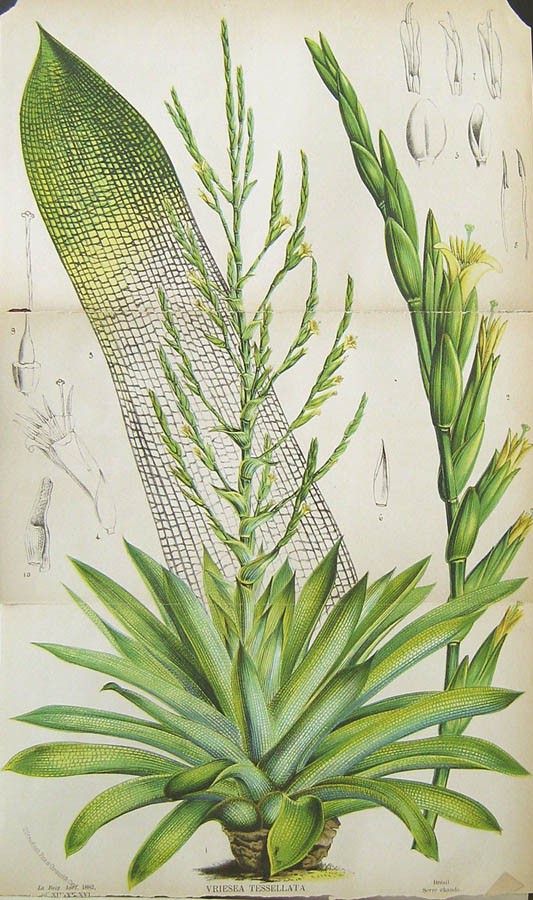
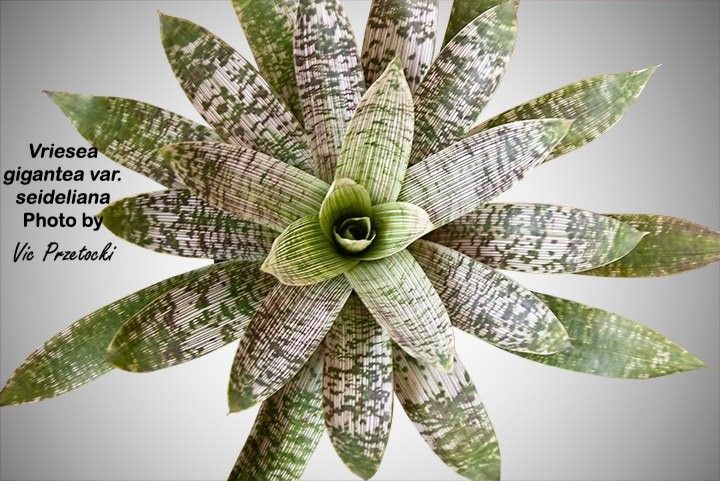
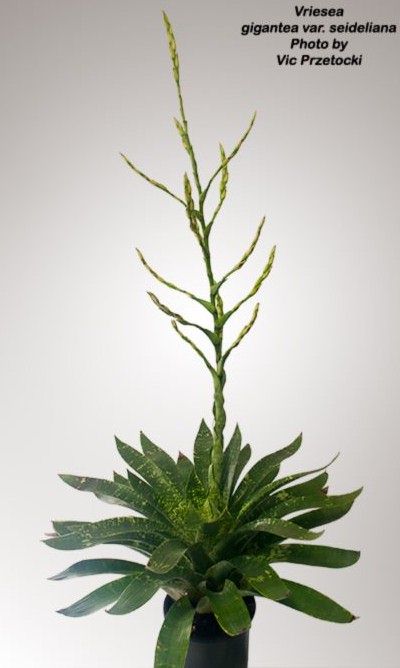
Desc from S&D
Plant flowering 2 m high.
Leaves many in a large broadly funnelform rosette, 6-10 dm long, minutely appressed-lepidote on both sides;
Sheaths large, very broadly elliptic, densely castaneous-lepidote;
Blades ligulate, broadly acute and apiculate, 6-9 cm wide, flat, wholly green;
Scape erect, stout;
scape-bracts subfoliaceous, acuminate, suberect, densely imbricate.
Inflorescence laxly bipinnate, 1 m or longer, ca 4 dm in diameter, nearly glabrous;
Primary bracts ovate, acuminate, shorter than the sterile bases of the branches;
Branches divergent, all subequal, laxly many-flowered, to 45 cm long with a long sterile base bearing 1-2 bracts; rhachis flexuous.
Floral bracts broadly elliptic, subacute, to 3 cm long, equaling the middle of the sepals, convex, ecarinate, not incurved, coriaceous;
Flowers distichous, rarely somewhat secund, suberect.
Sepals elliptic, subacute, to 37 mm long, ecarinate;
Petals ligulate, obtuse, 4-5 cm long, greenish yellow, bearing 2 long acute scales at base,
Stamens included; filaments enlarged toward apex.
Capsule cylindric, acute, 4 cm long.
Type. Gaudichaud 127 in part (holotype P, GH photo; isotype B, F photo 11467), Ilha de Santa Catarina, Florianopolis, Santa Catarina, Brazil.
DISTRIBUTION. Terrestrial and Epiphytic in coastal forest, 5-500 m ah, Espirito Santo to Rio Grande do Sul in eastern Brazil.
BRAZIL. ESPIRITO SANTO: Monte Claro, Collatina, 20 Jul 1939, Foster 230 (GH, R); Linhares, Collatina, 2 Aug 1940, Foster 788 (GH, US). RIO DE JANEIRO: Cantagallo, cult. 25 Mar 1884, Glaziou 15467 (P): Estrada Velha de Petropolis, 10 Apr 1952, L. B. Smith & Mus R 6499 (R, US). SAO PAULO: Sao Paulo, 28 Jan 1931, Roehne s n (SP); 1939, Foster 346 (GH, R, US). Alto da Serra, 10 Mar 1929, L.B. Smith 2100 (GH, S). PARANA: Jacarei,cult. 5Apr 1911, Dustin 11763 (GH, S, US); Caioba, 30 Aug 1939, M. Kuhlmann s n (SF, US); Foster 431 (GH, US); Guaratuba, 3 Feb 1952, Reitz 4244 (HBR); 21 Feb 1952, L. B. Smith & Reitz 5729 (R, RB, US). SANTA CATARINA: Ponta Grossa, Ilha de Santa Catarina, 12 Dec 1951, Reitz 4366 (HBR); Laguna, 19 Sep 1951, Reitz & Klein 96 (HBR); Sombrio, Reitz C-1009 (GH, HBR); 24 Mar 1952, 4664 (HBR); Azambuja, Brusque, Reitz 3531 (HBR) Brusque, Reitz 3593 (HBR); Itajai, 2 Feb 1952, Reitz 4242 (HBR); Itajuba, Araquari, 2 Feb 1952, Reitz 4243 (HBR); Corupa, 5 Feb 1952, Reitz 4245 (HBR); Blumenau, 6 Feb 1952, Reitz 4246 (HBR, flowers partly secund); Garcia, Blumenau, 21 Mar 1952, Reitz 4648 (HBR); L. B. Smith & Reitz 6301 (R, US); Campo de Massiambu, Palhoca, Reitz 4957 (! Reitz); Ibirama, 1 Mar 1954, Reitz & Klein 1576 (HBR, US); Camboriu, 16 Apr 1954, Reitz & Klein 1788 (HBR, US). RIO GRANDE DO SUL: Gloria, Porto Alegre, 5 Jan 1934, Orth s n (SP); Sao Salvador, Dec 1941 Eugenio 2235 (GH); Sao Leopoldo. Feb 1942,Eugenio 126 in part (R); Esteio. 18 May 1949. Rambo s n (PACA, US); Lagoa dos Quadros, near Torres, 28 Jan 1951, Rambo s n (PACA. US).
Vriesea gigantea var. seideliana Roeth Die Bromelie 1/1992
Differs from Type in equally broad and whitish leaves with dark longitudinal nerves and spotted markings at tips.
Habitat – Brazil, Espirito Santo, near Santa Leopoldina, ca 600m
Was known in the ‘Trade’ in the USA as ‘Nova’ - See Bromeliad Cultivar Registry.
Vriesea gigantea GAUDICHAUD. Atl. Voy. Bonite, pl. 70, 1846 var. seideliana ROETH, var. nov.: Die Brom 1/1992
A varietate typica forma foliorum usque ad apicem aequaliter lata, et colore albescente foliorum, nervis et maculis in apice foliorum atroviridibus differt. Holotypos HAL No.069716.
Typus: Brasilia, Espirito Santo, prope urbem Santa Leopoldina, ca. 600 m s. m., coll. Alvim Seidel no. 940, 1982.
Vriesea gigantea GAUDICHAUD 1846 kommt in allen Kustenlandern Ostbrasiliens, in den Staaten Espirito Santo, Rio de Janeiro, Sao Paulo, Parana, Santa Catarina und Rio Grande do Sul vor. Sie wachst terrestrisch oder epiphytisch in Hohenlagen van 5-500 m uber dem Meeresspiegel. V. gigantea ist in Wuchsform und -grosse relativ einheitlich, lediglich die Blatter sind unterschiedlich lang zugespitzt.
Die Varietiit seideliana ROETH weicht von der Art durch die bis zur Spitze weitgehend gleichmassig breite Blattform sowie weissliche Blutter mit dunkelgrunen Lungsnerven und dunkelgruner fleckiger Zeichnung an der Blattspitze ab. Sie wird zu Ehren des Ent-deckers der Varietat Alvim Seidel, Curupa, Santa Catarina, Brasilien "seideliana" ge-nannt.
Verbreitung: Brasilien, Espirito Santo bei Santa Leopoldina, Santa Teresa und Jetiba, ca. 600 m s. m. Vriesea gigantea var. seideliana kommt nicht gemeinsam mit der var. gigantea vor. Ob sich beide Varietaten chorologisch ausschliegen oder uberlagern, ist nur durch Feldstudien zu klaren.
Die abweichende, auch bei einer Vermehrung durch Samen konstante Blattfurbung der neu beschriebenen var. seideliana aus Espirito Santo rechtfertig die Abtrennung dieses Taxons von Vriesea gigantea.
Autor:
Jurgen Roeth, Botanischer Garten der Martin - Luther - Universitat,
Am Kirchtor 3, 0-4020 Halle/Saale.
Detail from Baker 1889
298. T. RETICULATA Baker in Gard. Chron.1887, i. 140.
Vriesea reticulata E. Morren (M.D.).
Leaves 30-40 in a dense rosette, lorate from an ovate base 4-5 in. broad, 1½-2 ft. long, 2½-3 in. broad at the middle, thin, flexible, subglabrous, marked all over with very distinct cross-veins of green on a pale ground. Peduncle stout, stiffly erect, as long as the leaves; bract-leaves ovate, erecto-patent. Infloresconce a lax panicle 3-4 ft. long,with many ascending laxly-flowered branches; branch-bracts small, ovate; flower-bracts oblong, acute, green, 1-1¼ in. long. Calyx green, half as long again as the bract. Petal-blade small, white, suborbicular. Stamens as long as the petals.
Hab. South Brazil; Rio Grande do Sul. Described from a plant flowered by Mr. Wm. Bull in March, 1873.
Vriesea tessellata roseo-picta by Jolibois in Revue Horticole 56: 374-5. 1884
Translated by Derek Butcher
A few years ago, Mr. Herivaux, horticulturist, Boulevard Lefebvre, 33, Paris, received from Brazil a consignment of orchids: on examining them noticed, on a root of a Cattleya a young plant with the characteristic of a Bromeliad. He took care of it, nevertheless, but without attaching any particular importance to it. When the plant had developed a little, he believed that it looked like an Encholirion, and it was only later, when the plant was examined more closely, it seemed to be a Tillandsia or better still close to Vriesea, like V. tessellata, Ed André, (Lind in. Ill. hort., 1874, p123, cum ie.), of which it had the appearance, not so much by the shape and the disposition of the leaves but by the tessellations, that recalled, indeed, a sort of checkerboard as in V. tessellata, but with something more, however: large rose coloured stains, that with the black, white and green lined contrast, formed a harmonious contrast of a new species.
Although the general aspect of the plant recalls almost precisely V. tessellata, there was again, besides its rosy hue, a difference in the shape of the leaves whose extremities bend gracefully, as in the species Encholirion Jonghei and Saundersii, where they also have leaves narrow suddenly, truncated and ending in a short and wide spinescent mucron. Here is a short summary of the general characters of V. tessellata roseo-picta:
Plant of good vigour, has stature and general looks of V. tessellata. Leaves very close together, extensively channelled, dark in the bottom part, imbricate, lined and cross markings as in the type, and underneath, is accompanied by large rose coloured stains closely and regularly disposed that produce a charming contrast; the top of the leaf arches, is reflexive, suddenly narrows, is truncated, and ends in a stiff spinescent, blackish, mucron.
The pink blotching begins to appear at the top of the leaf and grows little by little to the base, so that the young leaves are less marked than the old.
The plant in question, that I grow in an Orchid greenhouse, is about 50 cm high and a similar width.